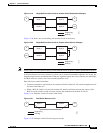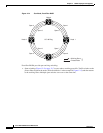
11-43
Cisco ONS 15454 Reference Manual, R7.0
78-17191-01
Chapter 11 Circuits and Tunnels
11.20 11.20 Reconfigured Circuits
• Circuits types must be a compatible. For example, you can combine an STS circuit with a VAP
circuit to create a longer VAP circuit, but you cannot combine a VT circuit with an STS circuit.
• Circuit directions must be compatible. You can merge a one-way and a two-way circuit, but not two
one-way circuits in opposing directions.
• Circuit sizes must be identical.
• VLAN assignments must be identical.
• Circuit end points must send or receive the same framing format.
• The merged circuits must become a DISCOVERED circuit.
If all connections from the master circuit and all connections from the merged circuits align to form one
complete circuit, the merge is successful. If all connections from the master circuit and some, but not
all, connections from the other circuits align to form a single complete circuit, CTC notifies you and
gives you the chance to cancel the merge process. If you choose to continue, the aligned connections
merge successfully into the master circuit, and the unaligned connections remain in the original circuits.
All connections in the completed master circuit use the original master circuit name.
All connections from the master circuit and at least one connection from the other selected circuits must
be used in the resulting circuit for the merge to succeed. If a merge fails, the master circuit and all other
circuits remain unchanged. When the circuit merge completes successfully, the resulting circuit retains
the name of the master circuit.
You can also merge orderwire and user data channel (UDC) overhead circuits, which use the overhead
bytes instead of frame payload to transfer data. To merge overhead circuits, you choose the overhead
circuits on the network view Provisioning > Overhead Circuits window. You can only merge orderwire
and UDC circuits.
11.20 Reconfigured Circuits
You can reconfigure multiple circuits, which is typically necessary when a large number of circuits are
in the PARTIAL status. When reconfiguring multiple circuits, the selected circuits can be any
combination of DISCOVERED, PARTIAL, DISCOVERED_TL1, or PARTIAL_TL1 circuits. You can
reconfigure tunnels, VAP circuits, VLAN-assigned circuits, VCAT circuits, CTC-created circuits, and
TL1-created circuits. The Reconfigure command maintains the names of the original cross-connects.
Use the CTC Tools > Circuits > Reconfigure Circuits menu item to reconfigure selected circuits. During
reconfiguration, CTC reassembles all connections of the selected circuits and VCAT members into
circuits based on path size, direction, and alignment. Some circuits might merge and others might split
into multiple circuits. If the resulting circuit is a valid circuit, it appears as a DISCOVERED circuit.
Otherwise, the circuit appears as a PARTIAL or PARTIAL_TL1 circuit.
Note If CTC cannot reconfigure all members in a VCAT circuit, the reconfigure operation fails for the entire
VCAT circuit and it remains in the PARTIAL or PARTIAL_TL1 status. If CTC does reconfigure all
members in a VCAT circuit, the VCAT circuit may still remain in the PARTIAL or PARTIAL_TL1
status. This occurs if the ports defined in the VCAT termination do not match the source/drop ports of
the member circuits or if one or two VCAT terminations are missing.
Note PARTIAL tunnel and PARTIAL VLAN-capable circuits do not split into multiple circuits during
reconfiguration.


















